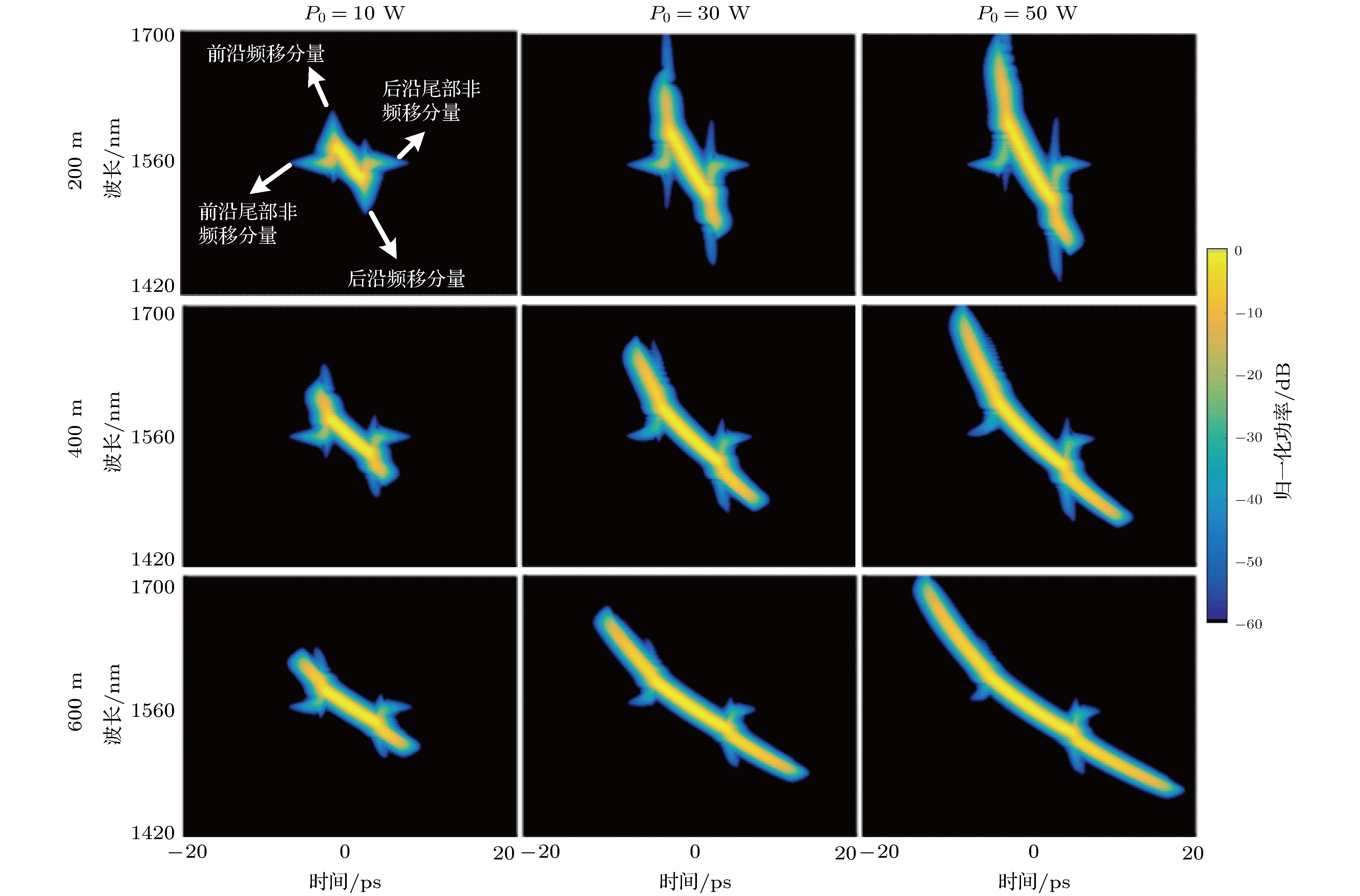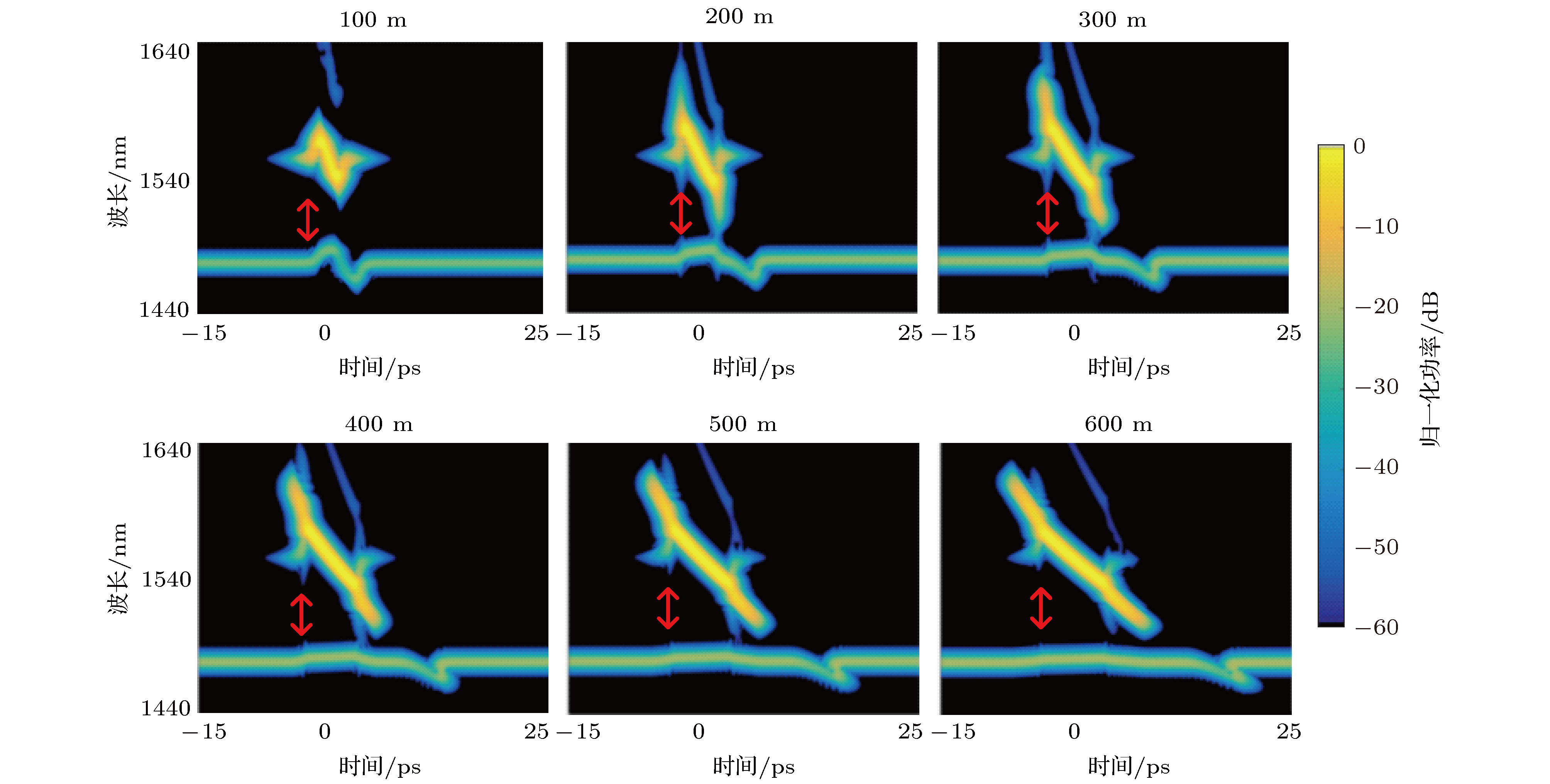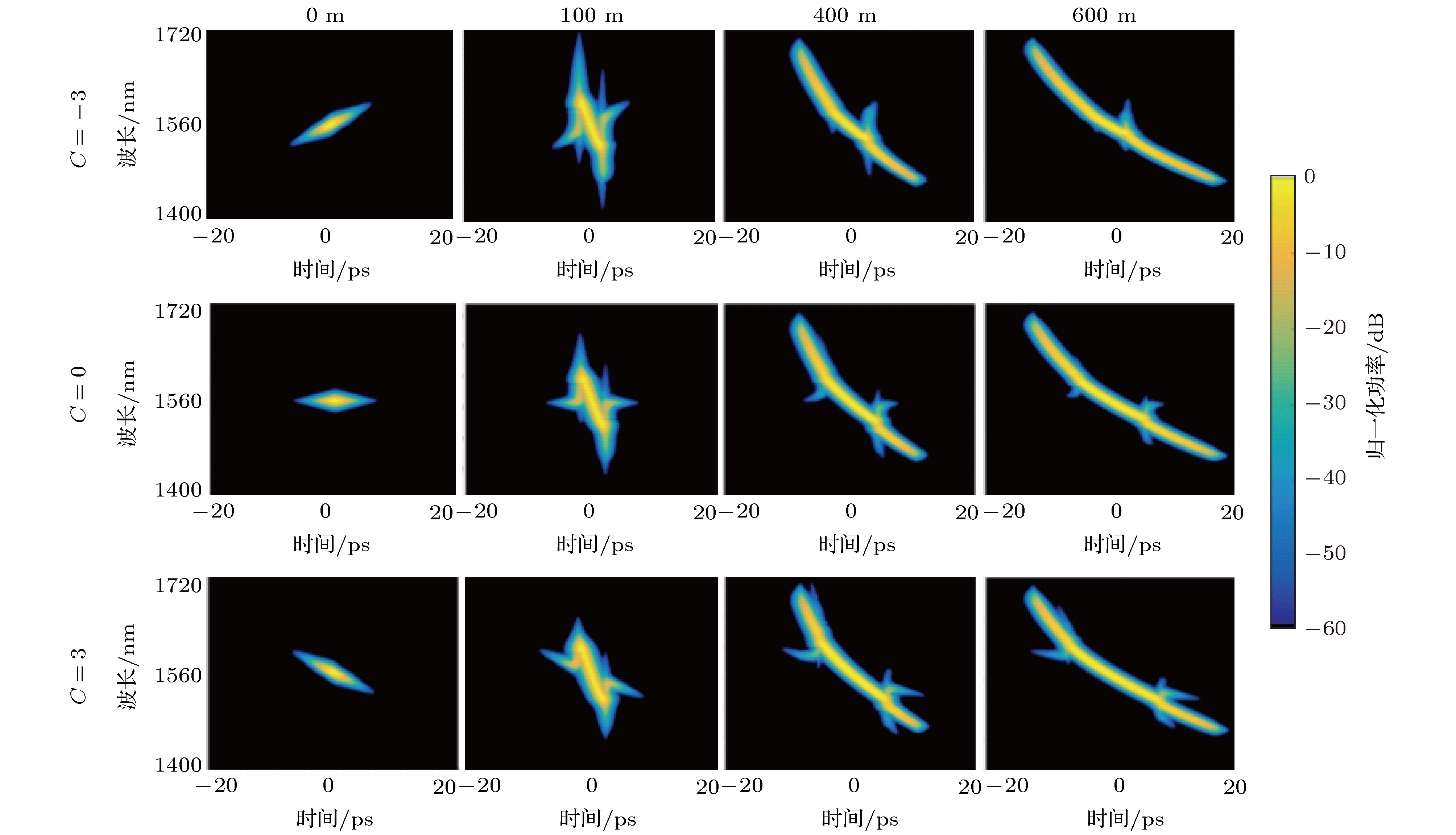-
基于广义非线性薛定谔方程(对皮秒双曲正割光脉冲在高非线性光纤(highly nonlinear fiber, HNLF)正常色散区传输时尾部非频移分量的演化情况进行了理论研究. 研究结果表明: 交叉相位调制(cross-phase modulation, XPM)和受激拉曼散射(stimulated Raman scattering, SRS)在其演化过程中起主导作用, 而三阶色散对其直接影响较小. 在XPM效应的作用下, 处于脉冲前沿和后沿尾部的非频移分量逐渐减弱, 其光谱分别发生红移和蓝移, 这一过程具有对称性; SRS会加速前沿尾部非频移分量的减弱过程, 而减缓后沿的减弱过程, 这一现象在脉冲峰值功率较高时更为明显. 从脉冲尾部非频移分量演化角度分析了啁啾脉冲在HNLF正常色散区的光谱和波形特性.Supercontinuum generated in normal dispersion region of highly nonlinear fiber (HNLF) is widely used in signal processing and communication benefiting from its good flatness and high coherence. Because of the normal dispersion, optical wave breaking (OWB) occurs when non-frequency shift components and frequency shift components caused by self-phase modulation (SPM) overlap in time domain, and ends when non-frequency shift components disappear. The evolution of non-frequency shift components at the front and rear edge of optical pulse play an essential role in the supercontinuum generation process. In this paper, the evolution of non-frequency shift components in normal dispersion region is numerically calculated and analyzed based on generalized nonlinear Schrödinger equation. The results demonstrate that non-frequency shift components shrink gradually as the pulse propagates in the normal dispersion region. Cross-phase modulation (XPM) and stimulated Raman scattering (SRS) play a major role in this process, while the third-order dispersion imposes little effect on it. Because of XPM, non-frequency shift components at the front and rear edge shrink gradually, and keep red shifting and blue-shifting respectively. The influence of XPM on the non-frequency shift components at both edges is symmetrical. However, the influence of SRS on the evolution of non-frequency-shift components at both edges is asymmetric. At the front edge, SRS transfers the energy from non-frequency shift component to frequency shift component, which is opposite to that at the rear edge. At the front edge, SRS accelerates the shrinking process of the non-frequency shift component, while it slows down the shrinking process at the rear edge. And this asymmetric effect is more obvious when the peak power of the pulse is higher and SRS is more efficient. The evolution of the non-frequency shift components of chirped pulses propagating in the normal dispersion region is studied. Comparing with the unchirped pulse, the non-frequency shift components at the front and rear edge of the chirped pulse have different wavelengths. For the negative chirped pulse, the wavelength spacing between the overlapped frequency-shift components and non-frequency shift components is larger, which is easier to satisfy the SRS gain range. Therefore, the evolution of non-frequency-shift components at the front and rear edge of the negative chirped pulse are more asymmetric due to the higher SRS efficiency. For positive chirped pulses, the wavelength spacing between the overlapped components is difficult to satisfy the SRS gain range. The evolution of non-frequency-shift components in the positive chirped pulses is more symmetrical due to the lower SRS efficiency.
-
Keywords:
- supercontinuum /
- nonlinear fiber optics /
- stimulated Raman scattering /
- cross-phase modulation
[1] Nguyen-The Q, Matsuura M, Kishi N 2014 IEEE Photon. Technol. Lett. 26 1882
 Google Scholar
Google Scholar
[2] Peacock A C, Campling J, Runge A F J, Ren H, Shen L, Aktas O, Horak P, Healy N, Gibson U J, Ballato J 2018 IEEE J. Select. Top. Quantum Electron. 24 3
 Google Scholar
Google Scholar
[3] Takada K, Yamada H, Okamoto K 1999 Electron. Lett. 35 824
 Google Scholar
Google Scholar
[4] Hu H 2017 Ph. D. Dissertation (Connecticut: University of Connecticut)
[5] Yang T, Dong J, Liao S, Huang D, Zhang X 2013 Opt. Express 21 8508
 Google Scholar
Google Scholar
[6] Ohara T, Takara H, Yamamoto T, Masuda H, Morioka T, Abe M, Takahashi H 2006 J. Lightw. Technol. 24 2311
 Google Scholar
Google Scholar
[7] Yu S, Bao F, Hu H 2018 IEEE Photon. J. 10 1
[8] Wu R, Torres-Company V, Leaird D E, Weiner A M 2013 Opt. Express 21 6045
 Google Scholar
Google Scholar
[9] Husakou A V, Herrmann J 2001 Phys. Rev. Lett. 87 203901
 Google Scholar
Google Scholar
[10] 刘楚 2012 博士学位论文(北京: 北京交通大学)
Liu C 2012 Ph. D. Dissertation (Beijing: Beijing Jiaotong University) (in Chinese)
[11] Dudley J M, Genty G, Coen S 2006 Rev. Mod. Phys. 78 1135
 Google Scholar
Google Scholar
[12] Hilligsøe K M, Andersen T V, Paulsen H N, Nielsen C K, Mølmer K, Keiding S, Kristiansen R, Hansen K P, Larsen J J 2004 Opt. Express 12 1045
 Google Scholar
Google Scholar
[13] Gu X, Kimmel M, Shreenath A, Trebino R, Dudley J, Coen S, Windeler R 2003 Opt. Express 11 2697
 Google Scholar
Google Scholar
[14] Agrawal G P 2006 Nonlinear Fiber Optics (4th Ed.) (San Diego: Claif) p31
[15] Kawanishi S, Takara H, Uchiyama K, Shake I, Mori K 1999 Electron. Lett. 35 826
 Google Scholar
Google Scholar
[16] Tomlinson W J, Stolen R H, Johnson A M 1985 Opt. Lett. 10 457
 Google Scholar
Google Scholar
[17] Finot C, Kibler B, Provost L, Wabnitz S 2008 J. Opt. Soc. Am. B 25 1938
 Google Scholar
Google Scholar
[18] Heidt A M, Hartung A, Bartelt H 2016 Generation of Ultrashort and Coherent Supercontinuum Light Pulses in All-Normal Dispersion Fibers (Berlin: Springer) pp 247-280
[19] Grischkowsky D, Courtens E, Armstrong J A 1973 Phys. Rev. Lett. 31 422
 Google Scholar
Google Scholar
[20] Lin Q, Agrawal G P 2006 Opt. Lett. 31 3086
 Google Scholar
Google Scholar
[21] Cristiani I, Tediosi R, Tartara L, Degiorgio V 2004 Opt. Express 12 124
 Google Scholar
Google Scholar
[22] Zhang Z, Chen L, Bao X 2010 Opt. Express 18 8261
 Google Scholar
Google Scholar
[23] Hult J 2007 IEEE J. Lightw. Technol. 25 3770
 Google Scholar
Google Scholar
-
-
[1] Nguyen-The Q, Matsuura M, Kishi N 2014 IEEE Photon. Technol. Lett. 26 1882
 Google Scholar
Google Scholar
[2] Peacock A C, Campling J, Runge A F J, Ren H, Shen L, Aktas O, Horak P, Healy N, Gibson U J, Ballato J 2018 IEEE J. Select. Top. Quantum Electron. 24 3
 Google Scholar
Google Scholar
[3] Takada K, Yamada H, Okamoto K 1999 Electron. Lett. 35 824
 Google Scholar
Google Scholar
[4] Hu H 2017 Ph. D. Dissertation (Connecticut: University of Connecticut)
[5] Yang T, Dong J, Liao S, Huang D, Zhang X 2013 Opt. Express 21 8508
 Google Scholar
Google Scholar
[6] Ohara T, Takara H, Yamamoto T, Masuda H, Morioka T, Abe M, Takahashi H 2006 J. Lightw. Technol. 24 2311
 Google Scholar
Google Scholar
[7] Yu S, Bao F, Hu H 2018 IEEE Photon. J. 10 1
[8] Wu R, Torres-Company V, Leaird D E, Weiner A M 2013 Opt. Express 21 6045
 Google Scholar
Google Scholar
[9] Husakou A V, Herrmann J 2001 Phys. Rev. Lett. 87 203901
 Google Scholar
Google Scholar
[10] 刘楚 2012 博士学位论文(北京: 北京交通大学)
Liu C 2012 Ph. D. Dissertation (Beijing: Beijing Jiaotong University) (in Chinese)
[11] Dudley J M, Genty G, Coen S 2006 Rev. Mod. Phys. 78 1135
 Google Scholar
Google Scholar
[12] Hilligsøe K M, Andersen T V, Paulsen H N, Nielsen C K, Mølmer K, Keiding S, Kristiansen R, Hansen K P, Larsen J J 2004 Opt. Express 12 1045
 Google Scholar
Google Scholar
[13] Gu X, Kimmel M, Shreenath A, Trebino R, Dudley J, Coen S, Windeler R 2003 Opt. Express 11 2697
 Google Scholar
Google Scholar
[14] Agrawal G P 2006 Nonlinear Fiber Optics (4th Ed.) (San Diego: Claif) p31
[15] Kawanishi S, Takara H, Uchiyama K, Shake I, Mori K 1999 Electron. Lett. 35 826
 Google Scholar
Google Scholar
[16] Tomlinson W J, Stolen R H, Johnson A M 1985 Opt. Lett. 10 457
 Google Scholar
Google Scholar
[17] Finot C, Kibler B, Provost L, Wabnitz S 2008 J. Opt. Soc. Am. B 25 1938
 Google Scholar
Google Scholar
[18] Heidt A M, Hartung A, Bartelt H 2016 Generation of Ultrashort and Coherent Supercontinuum Light Pulses in All-Normal Dispersion Fibers (Berlin: Springer) pp 247-280
[19] Grischkowsky D, Courtens E, Armstrong J A 1973 Phys. Rev. Lett. 31 422
 Google Scholar
Google Scholar
[20] Lin Q, Agrawal G P 2006 Opt. Lett. 31 3086
 Google Scholar
Google Scholar
[21] Cristiani I, Tediosi R, Tartara L, Degiorgio V 2004 Opt. Express 12 124
 Google Scholar
Google Scholar
[22] Zhang Z, Chen L, Bao X 2010 Opt. Express 18 8261
 Google Scholar
Google Scholar
[23] Hult J 2007 IEEE J. Lightw. Technol. 25 3770
 Google Scholar
Google Scholar
计量
- 文章访问数: 10233
- PDF下载量: 83
- 被引次数: 0














 下载:
下载:





